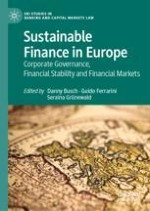2021 | OriginalPaper | Buchkapitel
11. The Taxonomy Regulation: More Important Than Just as an Element of the Capital Markets Union
verfasst von : Christos V. Gortsos
Erschienen in: Sustainable Finance in Europe
Aktivieren Sie unsere intelligente Suche, um passende Fachinhalte oder Patente zu finden.
Wählen Sie Textabschnitte aus um mit Künstlicher Intelligenz passenden Patente zu finden. powered by
Markieren Sie Textabschnitte, um KI-gestützt weitere passende Inhalte zu finden. powered by
